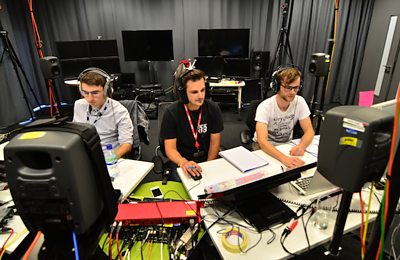
We have used our 3D audio technology to produce a special headphone mix of Tommies, ±«Óãtv Radio 4's World War One drama following the lives of signallers on the battlefront. Working with sound designer Caleb Knightley in our lab we have remixed the 21st October 1914 episode using binaural effects to achieve an enhanced immersive listening experience.
, after the programme has been broadcast.
You can read about Caleb's approach to mixing with our binaural system on the . As he mentions, we did not set out to be gimmicky, we wanted to use the tools that we have to enhance the original stereo mix with spatial effects whilst maintaining a high quality experience.
If you've not heard about binaural sound before, we've written about it a few times on . In brief, it aims to recreate the complex effect that the human body has on a sound reaching the auditory system to create a more realistic spatial impression for the listener. This effect can be created in recordings with dummy head microphone techniques and also in post-production using digital signal processing, which is the approach we have taken here. The primary application of binaural techniques is for headphone listening. We often call this 3D sound because it can give a plausible impression of sounds coming from outside of the listener's head at well defined positions in 3D space, as demonstrated in our .
One way in which binaural techniques are commonly used is to create virtual surround sound for headphones. In this approach existing surround sound content (such as a 5.1 mix) is rendered to a two-channel signal. On Saturday we released a player that does this in your web browser for a surround sound production of Under Milk Wood, you can read more about that . has shown that even with the state-of-the-art virtual surround systems we don't currently get a big improvement in quality over a conventional stereo down-mix. The perceived quality was found to vary significantly according to the source material used.
We strongly believe that binaural techniques can create significantly better listening experiences for our audience. In this production we have taken a different approach, rather than use virtual surround techniques, we have produced a dedicated headphone mix. We have applied a range of processing techniques to the different layers of each scene. We started from the original stereo multi-track session, including music, background sound, effects and dialogue layers. Using our production tools, each component could either be kept in stereo or binaurally positioned in 3D space. Three different binaural techniques were used: anechoic binaural filters, binaural filters measured in a real room, and a parametric binaural room simulator. Each of these seems to have advantages in certain situations, as does good old stereo.

Our aim was to provide Caleb with a set of tools and through practical investigation find out how they were best used for each different scene and the layers within it. The approach we have taken is to enhance the original stereo production, there are always stereo layers in the mix but we have used binaural processing to try to create a more spatious ambience and provide spatial effects where appropriate.
, after the programme has been . We will also be running an online survey to gather feedback about the experience, including a comparison between clips of the stereo and binaural headphone mixes. We would really appreciate your input to help us learn from this work and improve in the future.
-

Immersive and Interactive Content section
IIC section is a group of around 25 researchers, investigating ways of capturing and creating new kinds of audio-visual content, with a particular focus on immersion and interactivity.

